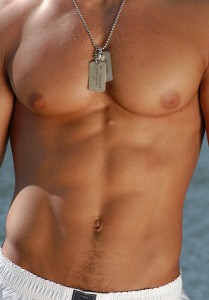Get a Beach Body in 3 Short Months
 If you want to unveil a chiseled physique, or at least one that’s svelter at the beach this summer, you’re going to need a game plan. Luckily, one has been provided for you and it requires no more than three weekly trips to your local gym — spending no more than an hour there each session, and a ton of dedication and intestinal fortitude.
If you want to unveil a chiseled physique, or at least one that’s svelter at the beach this summer, you’re going to need a game plan. Luckily, one has been provided for you and it requires no more than three weekly trips to your local gym — spending no more than an hour there each session, and a ton of dedication and intestinal fortitude.
The cornerstone movements
Seven movements, performed over the course of your three weekly workouts, will provide you an ample muscle building, fat incinerating stimulus.
Barbell Front Squat
Popularized by bodybuilders and used by Olympic weightlifters as an assistance exercise to the Clean and Jerk event, front squats target the quadriceps, while not beating up the shoulders and low back nearly as much as the back squat.
How to Front Squat
With an Olympic bar situated in a power rack at chest height, walk up to it, grasp it firmly, keeping a shoulder width, and pull the elbows up and through the bar. Get the core tight and take one step back with your dominant foot. Bring your non dominant foot back, meeting your dominant foot, maintaining a shoulder to hip width stance. Deeply inhale, keeping the core tight and shoot your hips rearward. Keep the upper back tight with the elbows up the entire time. Hold in the bottom for a split second before ascending. On the ascension, sit up by extending the hips and keeping the shoulders high. Remember to exhale. Get reset at the top and repeat.
Barbell Deadlift
Few exercises allow you to handle as much weight, nor deliver the growth hormone releasing effects of the deadlift. A staple in the routines of professional and collegiate athletes, bodybuilders, and strongman competitors, is probably the most demanding, yet rewarding movement of them all. Vast numbers of motor units in muscles are dispatched to assist in moving the weight, as is a connecting series of joints, including the hips, knees, shoulders, and ankles. All must work in unison to get the bar from the floor to waist height. It’s no wonder that deadlifts are among one of the elite total body strength exercises.
How to Deadlift
Assume a shoulder to hip width foot stance with an Olympic bar positioned directly over the mid foot. Shoot the hips back and down, away from the bar, while keeping your shoulders back. Grasp the bar with a double overhand grip, slightly outside of the knees. Brace the core, keeping the lower back arched (not rounded) slightly. Get the shoulders over the bar and higher than the hips. Drive through the heels to extend the hips and push the chest through, keeping the shoulders back. Your knees will extend as the bar passes them. Focus on pulling the bar back into to you, not up, as wrongly suggested by many trainers and coaches.
Overhead Press
The overhead press is one of those exercises that is commonly avoided by casual gym goers as it’s wrongly implicated in back and shoulder injuries. However, the majority of the people suffering from these injuries either don’t know how to perform an overhead press properly, or they’re using loads that are too great for their shoulder girdle and low back to handle.
How to Overhead Press
To overhead press correctly, you must position the bar in a power rack, approximately at chest height. With a slightly wider than shoulder-width grip, grasp the bar firmly, while retracting your shoulder blades and bracing the core. Keep the elbows close to the body and perpendicular with the floor. Unrack the bar, step back, keeping the feet positioned at feet to shoulder width and drive the elbows straight up. As the bar passes your face, pull the head through, so your ears are directly positioned beneath the bar with the elbows fully locked out. Doing so will reduce the amount of strain placed upon the shoulders.
Loaded Carry
There’s nothing more badass than picking up a pair of your gym’s heaviest dumbbells and taking a walk with them. However, there are a few caveats. In order to not injure yourself and to derive full benefits from this exercise, you must firmly grip the dumbbells, while keeping the head up and shoulders back. Keep the core tight and take deliberate, yet controlled steps. Keep the elbows locked out, as flexing them, will only tax your biceps and upper back, and tire your forearms even more. Walk for as long as possible before your form breaks down.
Pull Up
Pull ups have seemingly disappeared from the routines of many gym-goers and seeing them properly performed are rarer than holiday bonuses these days. Strength coach Todd Bumgardner, author of the Pull Up Manifesto, dubs them the “king of upper body exercises” and they are for great reason. Few exercises challenge the grip and require the fluid interaction of the core, shoulder girdle, elbows, and wrists as much as the pull-ups. They’re great for those desiring healthy shoulders, as they strengthen the scapulothoracic muscles — muscles which extend the thoracic spine and retract and depress the shoulder blades.
Pull Up Performance Cues
Hanging from a pull up bar with a fully clenched grip, in which the thumbs are wrapped around the bar, tighten the core, shoot the shoulder blades back and down — tucking them close to the spine and drive the elbows through the body. Don’t pull yourself to the bar with your arms, focus on driving the elbows back and behind you. Doing so, will activate the musculature of the upper back, giving you more firepower to complete the movement, and lessen the load on the elbow and wrist flexors. Altering your grip, even slightly, will vary the demand on different muscles. Flipping the grip with your palms facing you will hit the biceps harder. Keeping the palms facing each other will hit the trapezius and forearms harder and turning the palms away from your body will target the lats and rhomboids more.
Sprinting
Unplug your steady state workouts on the treadmill and hit the track, or field, or parking lot instead. Work up to performing shorter distance sprints, following a series of tempo sprints. Start at a distance of 20 yards or shorter, focusing on your burst, before going longer. Eventually you’ll work yourself up to distances around 100 yards, or meters, which will really challenge you. Be sure to incorporate adequate rest periods between your sprinting bouts. Ideally a work to rest ratio of 1:10 is ideal. For example, if it takes you 0:15 seconds to cover 100 yards, or meters, take 150 seconds, or 2:30 to rest. Active recovery in the form of walking, or light jogging, or a dynamic warm-up influenced movement, such as a lunge, or high knees, and hopping, will burn even more calories as it will keep the heart rate jacked up the entire time.
Jumping
Hundreds of books have been devoted to plyometric exercise, so we’ll keep it brief here. Take a gander at the physiques of football and basketball players the next time you watch a game and you’ll notice how explosively they jump, cut, and change directions. Although many pros are genetically elite, they jump higher and cut faster due to plyometric training. A beginner’s movement is the box jump, which teaches you to land as softly as possible after completing a jump of 2 to 3 feet high.
Grab a plyo box, bench, or sturdy table, or desk, ranging from knee to waist height with a surface that is large enough to land on. A surface that is at least 30” x 30” is ideal. Jump up and onto the surface, upon landing tighten up through the core, shoot the hips back and down and keep the shoulders directly over the knees, which will be slightly flexed. Remember to land as softly as possible. As box jumps get easier, progress to a box, or surface of a greater height, or move onto jump squats or vertical jumps.
For jumps squats, interlace your fingers behind your head and descend into a squat position, as you ascend, shoot the hips up quickly and jump as high as you can. Land in a quarter squat, again shooting the hips back and down, with the shoulders in line with the knees.
Once you’ve mastered jump squats, try jumping as high as you can. Reach for the sky at the top of the jump like you’re an invitee at this year’s NFL combine. If you have a basketball rim handy, aim for the rim. If you’re shorter, or aren’t that athletic shoot for the bottom of the net.
Sample Week
| Day One | Day Two | Day Three |
| Box Jumps 5 sets x 5 repetitions | Box Jumps 5 sets x 5 repetitions | Box Jumps 5 sets x 5 repetitions |
| Barbell Front Squat 4 x 12 | Pull Up 4 sets | Barbell Deadlift 4 x 5 |
| Barbell Overhead Press 3 x 10 | Push Up 3 sets | Leg Press 3 x 12 |
| Barbell Shrug 3 x 12 | Bodyweight Lunge 2 sets | Dumbbell Bench Press 3 x 12 |
| Lying Leg Curl 2 x 12 | Dumbbell Curl 2 sets | Cable Row 3 x 12 |
| Calf Raise 2 x 15 | Plank alternated with Crunch 3 seats each | Hanging Leg Raise 2 sets |
| Finisher: Loaded Carry 2 x 30 yards | Finisher: Sprint (work up to 2 40 yd sprints) | Finisher: Bodyweight Lunge 100 yards (take rest during lunge if needed) |
If you enjoyed this post, please consider to leave a comment or subscribe to the feed and get future articles delivered to your feed reader.



Comments
No comments yet.
Sorry, the comment form is closed at this time.